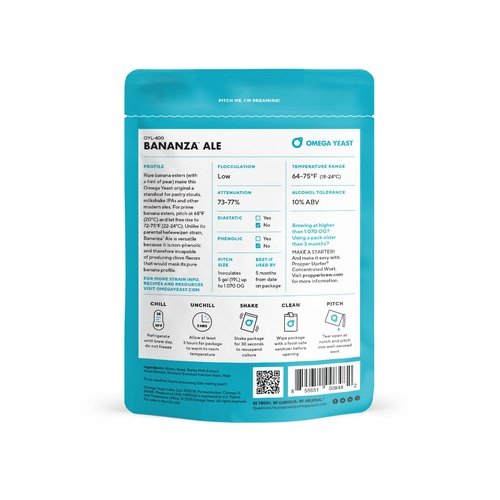 Image 1 of 3
Image 1 of 3

 Image 2 of 3
Image 2 of 3

 Image 3 of 3
Image 3 of 3




Omega I COSMIC Punch™ ALE I OYL-402
Introducing Cosmic Punch: A thiol-boosting version of British V
A Thiolized™ version of our popular hazy strain, British Ale V (OYL-011), Cosmic Punch™ Ale generates thiols through biotransformation, releasing tropical aromas experienced in southern hemisphere hops and New Zealand Sauvignon Blanc. This punchy strain unleashes vibrant passionfruit, grapefruit, and guava notes. Expect the same performance and haze you get from British V, but with additional thiol aromas. Experiment with mash hopping or wine grape-derived products to push even more thiols.
Attenuation: 71-75%
Flocculation: High
Alcohol Tolerance: 10% ABV
Optimum Fermentation Temp: 64-75°F
Cell Count: 200 Billion
For best results, use Phantasm Powder during whirlpool to add Thiol Precursors to your wort before fermentation.
Introducing Cosmic Punch: A thiol-boosting version of British V
A Thiolized™ version of our popular hazy strain, British Ale V (OYL-011), Cosmic Punch™ Ale generates thiols through biotransformation, releasing tropical aromas experienced in southern hemisphere hops and New Zealand Sauvignon Blanc. This punchy strain unleashes vibrant passionfruit, grapefruit, and guava notes. Expect the same performance and haze you get from British V, but with additional thiol aromas. Experiment with mash hopping or wine grape-derived products to push even more thiols.
Attenuation: 71-75%
Flocculation: High
Alcohol Tolerance: 10% ABV
Optimum Fermentation Temp: 64-75°F
Cell Count: 200 Billion
For best results, use Phantasm Powder during whirlpool to add Thiol Precursors to your wort before fermentation.
Introducing Cosmic Punch: A thiol-boosting version of British V
A Thiolized™ version of our popular hazy strain, British Ale V (OYL-011), Cosmic Punch™ Ale generates thiols through biotransformation, releasing tropical aromas experienced in southern hemisphere hops and New Zealand Sauvignon Blanc. This punchy strain unleashes vibrant passionfruit, grapefruit, and guava notes. Expect the same performance and haze you get from British V, but with additional thiol aromas. Experiment with mash hopping or wine grape-derived products to push even more thiols.
Attenuation: 71-75%
Flocculation: High
Alcohol Tolerance: 10% ABV
Optimum Fermentation Temp: 64-75°F
Cell Count: 200 Billion
For best results, use Phantasm Powder during whirlpool to add Thiol Precursors to your wort before fermentation.

Cosmic Punch® Ale (OYL-402) is the first strain released as a part of a Thiolized® series from our R&D team. Our Thiolized process enhances a yeast’s natural ability to biotransform compounds found in malt and hops to unleash thiols that evoke grapefruit, passion fruit and guava aromas reminiscent of New Zealand Sauvignon Blanc and Southern Hemisphere Hops. The parental strain, British V (OYL-011), is a staple for making hazy New England IPAs but is now capable of producing significantly enhanced tropical aromatics while maintaining the well-known characteristics of the original strain, allowing you to pack even more desirable aromas into each pint.
The term “biotransformation” refers to the development of new aromas and flavors as result of yeast activity on hop compounds. Brewers already use mid-fermentation dry hopping to promote biotransformation and the development of highly sought after aromas.
The types of biotransformation events can be grouped into two categories
1. the conversion of aroma compounds
2. the release of aroma compounds from precursor forms
For the first category, there is a lot of evidence for conversion of monoterpene alcohols (geraniol to β‑citronellol) changing the hop aroma profile from rose-like to more lemon-lime. The evidence for the release of aroma compounds from precursor forms has remained more elusive. Precursors of monoterpene alcohols that are glycosidically bound exist, but the levels are relatively insignificant to provide additional aroma impact. For another class of hop compounds — thiols — the opposite scenario exists where the majority of these are non-aromatic thiol precursors. Unfortunately, baseline yeast biotransformation of thiol precursors is very inefficient in wort. Cosmic Punch has been specifically developed to give you access to biotransformation of these thiol precursors, promoting more tropical and citrus aromas in your beer.
What are thiols and where do they come from?
Volatile thiols are highly impactful aroma compounds that evoke grapefruit, passion fruit and guava and are found in a variety of tropical fruits, wine grapes, hops and even barley. These thiol compounds exist in two forms — free forms, which are highly aromatic and volatile, and precursor forms (i.e. glutathione and cysteine-bound thiols). The precursor forms are non-aromatic and require yeast with β‑lyase biotransformation activity to release them. Hop varieties vary widely, not only in the amount of thiol compounds, but also the percentage that are in the non-volatile precursor form. New World Hop varietals, specifically Southern Hemisphere Hops, are highest in free thiols, which contribute to their characteristic tropical fruit aromas. 3‑sulfanyl-1-hexanol (3SH, but also referred to as 3MH), known for its intense grapefruit and passion fruit aromas, is abundant in barley but does not reach sensory thresholds because it is locked up the precursor form. In beer and wort, the overwhelming majority of these thiol compounds are in precursor form (1000-fold) and are a stockpile of aroma potential with a yeast capable of biotransforming them to the free volatile and aromatic thiol compounds.
β‑lyase — The yeast key to unlocking aromatic thiols
The IRC7 gene in yeast encodes a β‑lyase enzyme that frees thiols from the precursor form. Many brewing strains have inactivating mutations in the IRC7 gene that disable the enzyme. In another cruel twist, we have found that strains that have a functional IRC7 gene do not make the enzyme in wort because the gene is turned off in the presence of high nitrogen levels common to wort.
These insights made us think — if we altered the IRC7 promoter (the sequence upstream of a gene that controls its expression) to a version that keeps the gene on all the time (even in the presence of high nitrogen levels), could this be the key to unlocking thiol precursors that are so abundant in hops and malt?
We tried this first in the popular British V strain — and replaced the inactive IRC7 promoter with a highly active promoter. 3SH levels in the beers made with this strain remained unchanged in comparison to our parent British V strain. It turns out that British V has multiple mutations that inactivate its IRC7. Consequently, it doesn’t matter how much enzyme is made in that strain because it just plain doesn’t work!
With more investigation, we discovered that the IRC7 gene in West Coast I was functional (though turned off in wort). When we combined this West Coast I IRC7 gene and the highly active promoter we saw massive results! Using CRISPR-cas9, we added this activated version of IRC7 into British V. This “Thiolized” British V — our newly released Cosmic Punch — promotes biotransformation of precursor thiols to release big tropical aromatics in hazy IPAs.
Mash Hopping — Packing in More Precursor
Adding hops to your mash to increase tropical aromatics? Sounds crazy, right?
Other researchers have shown that malt has high levels of glutathione-bound 3SH and also presented evidence that mashing helps to convert some of the glutathione-bound 3SH to cysteine-bound 3SH.
As explained above, this conversion alone doesn’t do the brewer much good with most brewing yeast. This is because most strains either have non-functional IRC7 genes and/or negative regulation of IRC7 in wort meaning the critical enzyme needed to perform the conversion is not made.
But what happens if you add hops with high amounts of thiol precursors to the mash? Can you help to convert these precursors from glutathione-bound to cysteine-boundand get even more biotransformation activity with Cosmic Punch?
This is where things get truly exciting. When we included Cascade hops in the mash, 3SH levels increased nearly 10-fold with Cosmic Punch in comparison to the parent, British V. Even compared to the whirlpool condition with Cosmic Punch, mash hopping provided greater than two times the free 3SH. In other words, when using Cosmic Punch, mash hopping provided greater 3SH aromatic potential than a traditional method for providing hop aromatics — whirlpool hopping!

Types of Hops for Mash Hopping
Based on sensory from some of our in-house experiments we’ve found the following hops can be used in mash hopping to provide even more thiol precursors to Cosmic Punch in fermentation: Calypso, Cascade, Mittelfrüh, and Saaz.
Research from Roland et al. 2017 showed that these hops are loaded with precursor thiol compounds. Other hops have been found to have high precursor levels as well (ie. Apollo, Eureka, Hallertau Hallertauer, Nugget, and Hallertau Perle). Environmental factors that hop growers contend with (e.g. temperature, precipitation, elevation, geographical location, etc.) have an impact on the composition of precursors in hops. Even the same hop variety can vary between lots and harvest year when grown on the same farm. Hop suppliers do not currently list the thiol precursor levels in their hops because until now, this potential was unknown. Given these factors, trying to definitively say which hop varieties are best for mash-hopping is tricky.
Regardless of the hop variety used, mash-hopping itself has consistently shown itself to be a reliable way to form a larger pool of thiol precursors. We recommend lower alpha acid hops to avoid over-bittering (assume 30% of the IBU levels that you would get with a beginning of boil addition) and to avoid expensive aroma hops because much of the other volatile hop aroma compounds will be lost in the boil and beginning of fermentation. In the lab we have had consistently pleasing results using Saaz and Cascade!
Wine-Derived Precursors — Reimagined Oenobiers
When talking about thiols, it is hard to not recognize the enormous amount of work that has been done in wine to study these incredible compounds. Just like hops and malt provide loads of precursor thiols, wine grapes do as well.
Decades of wine research has shown that types and amounts of thiol compounds vary by variety, growing region and cultivation practices, and we know from recent research in beer that this plays out similarly with hops and barley. This sparked our interest in using wine grape-derived products in beer to pack even more precursor thiols into the wort. We experimented with different varieties of grape juices and grape skin-derived products and the results were staggering. Thiol compounds were reaching even higher levels in the finished beer — above 10-times the sensory threshold.
Serendipitous to the discoveries in our R&D program, a product called Phantasm was beginning to create a buzz in the brewing industry. This product is a downstream application of the grape-skins after the wine-making process has extracted the juice. Also, it comes from the Marlborough region of New Zealand, famous for producing the most punchy sauvignon blancs in the world. Lucky for us, the skins of grapes are enriched in thiol precursors. The beers that are made with these grape-derived products can enhance the grapefruit, passion fruit and guava citrus notes immensely. This opens up an entirely new potential for oenobiers, which is a beer-wine hybrid style that Cosmic Punch and our Thiolized yeast strains are now making possible!

We’re beyond excited to provide these new strains and methods to enable brewers to bring the people what they want — MORE HOP FLAVOR AND AROMA!!
*Information provided by Omega Yeast










